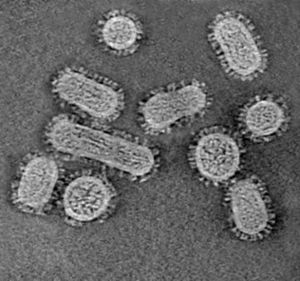La transcripción es un paso clave para la multiplicación del virus durante el cual se produce el ARN mensajero, el “molde” para generar las proteínas virales. Este proceso es llevado a cabo por unas moléculas llamadas ribonucleoproteínas (o RNPs), que son unos complejos formados por proteínas y el ARN que contiene el material genético del virus. Estas RNPs tienen una estructura helicoidal gracias a una de sus proteínas, llamada NP, y en uno de los extremos de esta hélice se encuentra la polimerasa, encargada de copiar el RNA del virus. El nuevo mecanismo de transcripción muestra como las RNPs son extremadamente flexibles y la polimerasa se desliza a lo largo de esta estructura helicoidal a modo de “tornillo sin fin”, para copiar el ARN de manera muy eficiente.
“Esta flexibilidad de las ribonucleoproteínas virales es clave para que realicen su función y además explica cómo el virus es capaz de generar una gran cantidad de proteínas a partir de un número limitado de genes al comienzo de la infección, una cuestión que estaba pendiente de responder desde hacía años”, aclara el investigador del CSIC Jaime Martín-Benito.
En la investigación, los científicos también han determinado el mecanismo de acción de un potente inhibidor del virus, cuya eficacia se debe a que produce rigidez en las ribonucleoproteínas, lo que impide la producción de ARN mensajero. Las imágenes de microscopía muestran que el tratamiento con el inhibidor produce un cambio en la estructura de las ribonucleoproteínas, el cual impide el movimiento de deslizamiento y anula la expresión de los genes virales en las células infectadas, lo que desemboca en la pérdida de funcionalidad del virus.
“En este contexto, el descubrimiento de este mecanismo podría abrir la puerta al diseño de nuevos fármacos antivirales que puedan bloquear el proceso descrito y ayuden a defendernos de futuras pandemias”, resalta Martín-Benito.
Una combinación de técnicas
Los investigadores han combinado para este trabajo técnicas de criomicroscopía electrónica y bioquímica, un tándem que permite, a partir de la visualización de moléculas durante su funcionamiento, entender cuál es su mecanismo de acción.
El equipo coordinado por Martín-Benito lleva años usando estas aproximaciones con el virus de la gripe para visualizar las ribonucleoproteínas virales. Ya en 2012 resolvieron la estructura de estas proteínas, tanto aisladamente como dentro de la partícula viral, la cual fue determinada con la mayor resolución hasta ese momento.
“Uno de los grandes desafíos de esta técnica es incrementar la resolución con la que se obtienen las estructuras de las moléculas bajo estudio. Con la aparición de microscopios cada vez más potentes pensamos que podríamos estudiar mejor las características de estos complejos multiproteicos, a pesar de la extrema flexibilidad de las moléculas, que dificulta mucho el procesamiento de los datos”, añade el investigador del CSIC.
Más información
Structural insights into influenza A virus ribonucleoproteins reveal a processive helical track as transcription mechanism. Rocío Coloma, Rocío Arranz, José M. de la Rosa-Trevín, Carlos O.S. Sorzano, Sandie Munier, Diego Carlero, Nadia Naffakh, Juan Ortín and Jaime Martín-Benito
Nature Microbiology
DOI: 10.1038/s41564-020-0675-3






